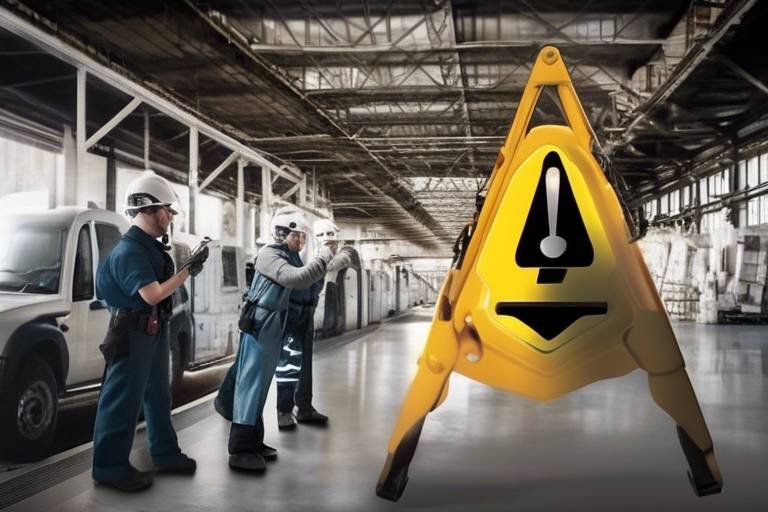Safety Measures: A Proof of Profound Understanding of Human Behavior
In a world that constantly presents us with various risks, understanding the psychology behind human behavior is essential for implementing effective safety measures. Why do some people comply with safety protocols while others blatantly ignore them? This article explores the intricate relationship between safety measures and human behavior, diving deep into the psychological aspects that influence our decision-making and risk assessment in various environments. By grasping the underlying motivations and emotional responses that drive behavior, we can develop safety programs that not only protect individuals but also resonate on a personal level.
Imagine walking into a workplace where safety signs are plastered everywhere, warning you about potential hazards. You might feel a sense of caution, but do those signs actually change your behavior? This leads us to the fascinating world of risk perception—the lens through which we view potential dangers. Our understanding of risk is shaped by numerous psychological factors, including past experiences, cultural influences, and even media portrayals of safety issues. For instance, if someone has previously experienced a workplace accident, they may become hyper-aware of safety measures, leading to a heightened perception of risk. Conversely, if an individual has never faced a safety issue, they might underestimate the importance of compliance.
Moreover, behavioral psychology provides valuable insights into why people adhere to or disregard safety measures. It’s not just about knowing the rules; it’s about understanding the motivation behind compliance. Motivation can be categorized into two types: intrinsic and extrinsic. Intrinsic motivation comes from within, fueled by personal values and beliefs about safety. For example, an individual who genuinely cares about their own well-being and the safety of their colleagues is more likely to follow safety protocols. On the other hand, extrinsic motivation is driven by external factors, such as rewards or penalties. This could include a bonus for maintaining a safe work environment or the fear of disciplinary action for failing to comply.
Understanding risk perception is about recognizing that not everyone sees danger the same way. Factors such as age, experience, and even social circles can influence how we interpret risks. For instance, younger individuals may engage in riskier behaviors, often believing they are invincible, while older adults might take a more cautious approach. This variation is crucial when designing safety measures, as it emphasizes the need for tailored approaches that consider the unique perspectives of different groups.
When we delve into behavioral psychology, we find that the adherence to safety measures is not merely a matter of knowledge but rather a complex interplay of psychological factors. Factors like motivation, emotions, and social influences play significant roles in determining how individuals respond to safety protocols.
Motivation is a powerful driver of behavior, especially regarding safety compliance. Individuals are more likely to adhere to safety measures if they feel a genuine desire to do so. This could stem from personal experiences, a sense of responsibility, or even a desire to protect loved ones. On the flip side, when motivation is lacking, individuals may neglect safety protocols, believing that nothing bad will happen to them. This highlights the importance of fostering a culture of safety where individuals feel personally invested in their own well-being and that of their peers.
Understanding the difference between intrinsic and extrinsic motivation is key to designing effective safety programs. Programs that appeal to intrinsic motivation—such as those that emphasize personal responsibility and the intrinsic value of safety—tend to yield better long-term compliance. In contrast, solely relying on extrinsic motivators, like penalties or rewards, may lead to short-term compliance but fail to instill a lasting commitment to safety.
Social dynamics are another significant factor influencing motivation. Peer pressure can either encourage or discourage adherence to safety measures. In environments where safety is prioritized and reinforced by group norms, individuals are more likely to follow suit. Conversely, in settings where safety is downplayed or ignored, individuals may feel compelled to conform to those norms, even at the risk of their safety.
Emotions also play a crucial role in how individuals react to safety measures. Fear can be a double-edged sword; while it can motivate individuals to comply with safety protocols, it can also lead to anxiety and resistance. Understanding these emotional responses can help organizations design safety measures that not only inform but also resonate emotionally with individuals, fostering a more profound commitment to safety.
Creating effective safety programs requires a solid understanding of human behavior. By aligning safety measures with psychological principles, organizations can significantly enhance compliance rates. This involves not only understanding motivation and emotional responses but also tailoring communication strategies to resonate with individuals on a personal level.
Effective communication is paramount in promoting safety measures. It’s essential to use clear, relatable messaging that enhances understanding and encourages adherence. For instance, instead of using technical jargon that may confuse individuals, safety communications should be straightforward and engaging, making the importance of compliance clear and relatable.
Feedback mechanisms are crucial for reinforcing safe behaviors. Regular feedback helps individuals understand their performance concerning safety protocols and encourages compliance. This could be in the form of safety meetings, reports, or even informal check-ins that foster a culture of safety within organizations.
- What are safety measures? Safety measures are protocols and practices designed to protect individuals from harm in various environments.
- How does human behavior influence safety compliance? Human behavior influences safety compliance through factors like motivation, emotional responses, and social dynamics.
- What role does motivation play in safety adherence? Motivation drives individuals to prioritize safety, with intrinsic motivators often leading to better long-term compliance.
- How can organizations improve safety compliance? Organizations can improve safety compliance by understanding human behavior and tailoring safety programs to resonate with individuals.

Understanding Risk Perception
Risk perception is a fascinating concept that shapes how we navigate our daily lives, influencing everything from our decision-making processes to our responses to safety protocols. It's like wearing a pair of glasses that color our view of the world—sometimes we see danger lurking around every corner, while other times, we may be blissfully unaware of potential hazards. But what exactly drives this perception? A myriad of psychological factors come into play, all of which can significantly impact how we assess risk in various environments.
At the core of risk perception lies our personal experiences and knowledge. For instance, someone who has had a negative experience with a particular safety issue—say, a car accident—might view driving as a high-risk activity. Conversely, a person who has never encountered such an event may underestimate the dangers involved. This discrepancy in perception can lead to vastly different behaviors when it comes to adhering to safety measures. Furthermore, cultural background, societal norms, and even media portrayals can skew our understanding of risk. It's almost as if we are all part of a giant psychological experiment, where our responses are shaped by the environment and the information we consume.
Moreover, the concept of availability heuristic plays a crucial role in risk perception. This mental shortcut leads individuals to judge the likelihood of an event based on how easily examples come to mind. For instance, if a person frequently hears about airplane crashes in the news, they may perceive flying as more dangerous than it statistically is. This bias can cause individuals to overestimate certain risks while downplaying others, leading to inconsistent behavior regarding safety measures.
Understanding risk perception is not just an academic exercise; it's essential for developing effective safety protocols. By recognizing how people perceive risk, organizations can tailor their safety measures to resonate more with individuals' psychological profiles. For example, if a company understands that its employees perceive a particular task as highly risky due to previous accidents, they can implement more stringent safety protocols and training to address those concerns. This alignment between perception and safety measures can enhance compliance and foster a culture of safety.
In conclusion, risk perception is a complex interplay of personal experience, societal influences, and cognitive biases. By delving into this intricate relationship, we can better understand how to craft safety measures that not only protect individuals but also resonate with their perceptions and emotions. This understanding is vital for creating environments where safety is prioritized and adhered to, ultimately leading to a more secure and conscientious society.

Behavioral Psychology in Safety
When it comes to safety, understanding behavioral psychology is like holding a treasure map that leads us to the heart of human actions. It's fascinating how our minds work, isn't it? Every day, we make decisions, often subconsciously, that can either keep us safe or put us at risk. Behavioral psychology helps us unravel the complex web of motivations, fears, and habits that dictate our adherence to safety measures. Think of it as a lens through which we can examine why some individuals diligently follow safety protocols while others might disregard them entirely.
One of the core concepts in behavioral psychology is the idea of cognitive biases. These are mental shortcuts that our brains take to make decisions quickly. For instance, someone might underestimate the risk of a workplace accident because they’ve never experienced one before. This bias can lead to a false sense of security, making them less likely to follow safety guidelines. On the flip side, someone who has witnessed an accident may become overly cautious, possibly to the point of being paralyzed by fear. Understanding these biases can help organizations tailor their safety programs to address these perceptions effectively.
Moreover, the theory of planned behavior is crucial in this context. This theory suggests that our intentions to engage in a behavior, like wearing safety gear, are influenced by three main factors: our attitude towards the behavior, the subjective norms surrounding it, and our perceived behavioral control. For example, if an employee believes that wearing a hard hat is essential (positive attitude), sees their colleagues doing the same (subjective norm), and feels confident in their ability to wear it correctly (perceived control), they are more likely to comply. This interplay is vital for understanding how to promote safety in any environment.
Another fascinating aspect of behavioral psychology in safety is the concept of habit formation. Habits are powerful; they can either help or hinder our safety practices. When safety measures become habitual, they require less cognitive effort, making compliance easier. To foster such habits, organizations can implement strategies like regular training sessions or reminders. For instance, a construction company might use visual cues, such as brightly colored signs or reminders on equipment, to reinforce safe practices. Over time, these cues can help form lasting habits that prioritize safety.
In addition to these psychological theories, it's essential to recognize the role of emotional responses in safety compliance. Emotions can significantly influence our actions. For example, fear of injury might compel someone to take safety measures seriously, while overconfidence might lead to negligence. By understanding the emotional triggers that affect safety behavior, organizations can create more effective safety programs. They could incorporate storytelling or real-life testimonials in training sessions, helping employees connect emotionally with the importance of safety measures.
In summary, the intersection of behavioral psychology and safety is a rich field of study. By understanding the psychological factors that influence behavior, organizations can create more effective safety protocols. This not only enhances compliance but also fosters a culture where safety is valued and prioritized. Remember, it's not just about rules and regulations; it's about understanding the human element that drives these behaviors.
- What is behavioral psychology? Behavioral psychology is the study of how people's thoughts, feelings, and behaviors are influenced by their environment and experiences.
- How does motivation affect safety compliance? Motivation, whether intrinsic or extrinsic, plays a crucial role in whether individuals choose to follow safety measures.
- Can emotions impact safety behavior? Yes, emotions such as fear or overconfidence can significantly influence whether individuals adhere to safety protocols.
- What strategies can improve safety compliance? Effective communication, feedback mechanisms, and habit formation strategies can enhance compliance with safety measures.

The Role of Motivation
When we talk about safety measures, motivation is the invisible force that drives individuals to either embrace or disregard these protocols. Imagine standing at a crossroads, with one path leading to safety and the other to risky behavior. What makes someone choose the safe route? The answer often lies in their motivation. It can be broadly categorized into two types: intrinsic and extrinsic. Intrinsic motivation comes from within; it’s that personal desire to keep oneself and others safe because it feels right. On the other hand, extrinsic motivation is fueled by external factors, such as rewards or the fear of penalties.
For instance, consider a worker in a factory setting. If they wear their safety gear because they genuinely believe it protects them, that’s intrinsic motivation at play. However, if they only wear it to avoid getting reprimanded by their supervisor, that’s extrinsic motivation. Understanding these types of motivation is crucial for designing effective safety programs. When individuals feel personally connected to safety measures, they are more likely to adhere to them consistently.
Moreover, motivation is not a one-size-fits-all concept. It can be influenced by various factors, including personal experiences, workplace culture, and even societal norms. For example, if a person has previously experienced an accident due to negligence, their intrinsic motivation to follow safety protocols might significantly increase. Conversely, in a workplace where safety is not prioritized, individuals may feel less compelled to comply with safety measures, highlighting the importance of fostering a culture of safety.
To illustrate the impact of motivation on safety compliance, consider the following table:
| Type of Motivation | Examples | Impact on Safety Compliance |
|---|---|---|
| Intrinsic Motivation | Personal beliefs, past experiences | Higher likelihood of adherence |
| Extrinsic Motivation | Rewards, penalties | Variable adherence based on external factors |
In summary, understanding the role of motivation in safety compliance is essential for creating effective safety measures. By tapping into both intrinsic and extrinsic motivators, organizations can design programs that resonate with individuals on a deeper level, ultimately leading to a safer environment for everyone.

Intrinsic vs. Extrinsic Motivation
When we talk about motivation, we often find ourselves navigating a complex landscape of influences that drive our behaviors, especially when it comes to adhering to safety measures. Intrinsic motivation refers to the drive that comes from within an individual. It's that feeling of satisfaction or pleasure you get from doing something because you genuinely enjoy it or believe in its importance. For instance, someone might follow safety protocols because they care about their own well-being or the well-being of their colleagues. This internal drive can create a stronger, more sustainable commitment to safety practices, as it aligns with personal values and beliefs.
On the flip side, we have extrinsic motivation, which is fueled by external factors. This could include rewards, recognition, or even the fear of penalties. Think about a workplace where employees are rewarded with bonuses for maintaining a safe environment. While this can effectively encourage compliance, the challenge lies in ensuring that these external motivators do not overshadow the intrinsic ones. If employees are only following safety measures for the reward, what happens when the reward is taken away? This raises an important point about the sustainability of safety behaviors driven primarily by external factors.
To illustrate the difference between these two types of motivation, consider the following table:
| Type of Motivation | Description | Examples |
|---|---|---|
| Intrinsic Motivation | Driven by internal satisfaction and personal values | Following safety protocols because you value safety or enjoy the feeling of contributing to a safe environment |
| Extrinsic Motivation | Driven by external rewards or consequences | Wearing safety gear to avoid fines or to receive bonuses from management |
Understanding the balance between intrinsic and extrinsic motivation is critical when designing safety programs. Ideally, effective safety initiatives should strive to enhance intrinsic motivation while also incorporating appropriate external motivators. For instance, organizations can foster an environment where safety is not just a rule to follow, but a shared value that everyone embraces. This can be achieved through training sessions that emphasize the importance of safety, recognition programs that celebrate individuals who prioritize safety, and creating a culture where employees feel empowered to speak up about safety concerns.
Ultimately, when individuals are intrinsically motivated, they are more likely to engage in safe practices consistently, even in the absence of external rewards. This leads to a more profound understanding of safety as a shared responsibility, creating a healthier and safer environment for everyone. So, the next time you consider how to encourage safety compliance, remember the powerful interplay between intrinsic and extrinsic motivation. It's not just about the rules; it's about fostering a culture where safety is valued from within.
- What is the difference between intrinsic and extrinsic motivation? Intrinsic motivation comes from within and is driven by personal satisfaction, while extrinsic motivation is influenced by external rewards or consequences.
- How can organizations enhance intrinsic motivation for safety? Organizations can enhance intrinsic motivation by promoting a culture of safety, providing training, and recognizing individuals who prioritize safety.
- Why is intrinsic motivation more sustainable than extrinsic motivation? Intrinsic motivation fosters a deeper connection to the behavior, making it more likely that individuals will continue to engage in safe practices even without external rewards.

Social Influences on Motivation
When it comes to safety measures, the power of social influences cannot be underestimated. Have you ever noticed how your friends' behaviors can sway your decisions? This phenomenon is a prime example of how social dynamics shape our motivations. People are inherently social beings, and our actions often reflect the norms and expectations of the groups we belong to. For instance, if everyone in your workplace adheres strictly to safety protocols, you’re more likely to do the same. Conversely, if safety measures are treated as optional, you may find yourself questioning their importance.
Peer pressure is a significant factor in this equation. It’s not just about the fear of judgment; it’s about the desire to fit in and be accepted. When individuals see their peers engaging in safe behaviors, it can create a ripple effect, encouraging others to follow suit. This is particularly evident in environments like construction sites or laboratories, where safety compliance is crucial. Imagine a scenario where a new safety protocol is introduced. If the majority of the team embraces this change and actively participates, the remaining individuals are likely to feel compelled to conform. This can lead to a culture of safety that not only protects individuals but also enhances overall group performance.
Moreover, social media has transformed the way we perceive safety behaviors. With the rise of platforms like Instagram and Facebook, individuals often share their experiences and practices regarding safety. This sharing can either promote positive behaviors or, conversely, lead to complacency. For example, a viral video showcasing unsafe practices can influence viewers to downplay the importance of safety measures. On the flip side, campaigns highlighting safe behaviors can create a community of advocates who inspire others to prioritize safety.
Additionally, group norms play a pivotal role in shaping individual motivations. When safety becomes a collective value within a group, it fosters a sense of accountability. Members feel responsible not just for their own safety but for the safety of their peers as well. This collective responsibility can be particularly potent in settings such as schools or sports teams, where camaraderie and teamwork are emphasized. For instance, a sports team that regularly discusses and practices safety protocols is likely to have players who take those measures seriously, not just for themselves but for the entire team.
In conclusion, understanding the social influences on motivation is crucial for developing effective safety programs. By leveraging these influences, organizations can create environments that encourage compliance and foster a culture of safety. After all, when individuals feel supported by their peers, they are more likely to embrace safety measures wholeheartedly. So, the next time you think about safety, consider the social dynamics at play and how they can drive positive change.
- How can social influences improve safety compliance?
Social influences, such as peer pressure and group norms, can motivate individuals to adhere to safety measures by fostering a sense of accountability and community. - What role does social media play in safety behaviors?
Social media can either promote safe practices through positive sharing or undermine them by showcasing unsafe behaviors, influencing public perception of safety protocols. - How can organizations leverage social dynamics for safety programs?
Organizations can create a culture of safety by emphasizing teamwork and accountability, encouraging individuals to support each other in adhering to safety measures.

Emotional Responses to Safety Protocols
When it comes to safety protocols, emotions can play a pivotal role in shaping our reactions and compliance. Think about it: when we feel threatened, our instinct is to protect ourselves, often leading us to adhere to safety measures more strictly. Conversely, when we perceive a situation as low-risk, feelings of complacency can set in, causing us to overlook essential safety protocols. This emotional rollercoaster can significantly influence how effectively we respond to safety guidelines.
One of the most compelling aspects of emotional responses is the concept of fear. Fear can be a double-edged sword; while it can motivate individuals to follow safety protocols, it can also lead to panic, resulting in irrational behavior. For example, during a fire drill, the fear of the unknown can prompt people to evacuate swiftly, but it can also create chaos if individuals become overly anxious. This highlights the importance of managing emotional responses effectively—creating a balance between alertness and calmness is essential.
Moreover, emotions like trust and confidence can significantly impact compliance with safety measures. When individuals trust the information provided and feel confident in their ability to follow safety protocols, they are more likely to adhere to them. For instance, if a workplace implements a new safety procedure, employees who trust their management and believe in the effectiveness of the measures are more likely to comply. On the other hand, if there is skepticism or a lack of transparency, employees might ignore the protocols, believing them to be ineffective or unnecessary.
Additionally, emotional responses can be influenced by social dynamics. When people see their peers following safety protocols, they are more likely to do the same. This phenomenon can create a positive feedback loop, where compliance becomes the norm, fostering a culture of safety. However, if individuals observe others disregarding safety measures, it can lead to a sense of desensitization, where they too begin to overlook important protocols. Therefore, understanding the emotional landscape within a group is crucial for promoting adherence to safety measures.
In summary, the interplay between emotions and safety protocols is complex yet fascinating. By recognizing the emotional factors that drive behavior, organizations can tailor their safety programs to better resonate with individuals. This not only enhances compliance but also fosters a deeper understanding of the importance of safety in our daily lives.
- Why are emotional responses important in safety compliance?
Emotional responses can significantly affect how individuals react to safety protocols, influencing their likelihood of adherence based on feelings of fear, trust, and social dynamics. - How can organizations manage emotional responses to improve safety compliance?
Organizations can manage emotional responses by promoting trust, providing clear communication, and fostering a supportive environment that encourages positive emotional reactions to safety protocols. - What role does peer influence play in safety behavior?
Peer influence can encourage compliance when individuals observe their peers following safety measures, creating a culture of safety that reinforces positive behavior.

Designing Effective Safety Programs
Creating effective safety programs is not just about implementing rules and regulations; it's about understanding the intricate tapestry of human behavior. When designing these programs, it's essential to recognize that people are not robots programmed to follow orders blindly. Instead, they are complex beings driven by emotions, motivations, and social influences. By tapping into these psychological elements, we can craft safety measures that resonate on a personal level, making them more likely to be embraced and adhered to.
One crucial aspect of designing effective safety programs is the alignment of safety protocols with the everyday realities of individuals. When safety measures are perceived as relevant and beneficial, compliance naturally follows. For instance, consider a workplace that implements a new safety protocol for handling hazardous materials. If employees understand the personal risks involved and see the direct benefits of the measures—like fewer accidents and a safer work environment—they are more likely to engage with the program enthusiastically. This connection between personal relevance and compliance cannot be overstated.
Another vital component is the importance of communication strategies. Clear, relatable messaging can significantly enhance understanding and adherence to safety protocols. Imagine a scenario where safety instructions are delivered in technical jargon that only a few can decipher. This approach can lead to confusion and, ultimately, non-compliance. Instead, using straightforward language and visual aids can help bridge the gap. For example, infographics that illustrate safety procedures can be far more effective than lengthy manuals. When people can visualize the steps they need to take, they are more likely to remember and follow through.
Furthermore, incorporating feedback mechanisms into safety programs is essential. Regular feedback not only reinforces safe behaviors but also fosters a culture of safety within organizations. For instance, when employees receive recognition for adhering to safety protocols, it not only boosts their morale but also encourages others to follow suit. Feedback can come in various forms, such as safety audits, peer reviews, or even informal check-ins. The key is to create an environment where safety is a shared responsibility, and everyone feels empowered to contribute.
In addition to these strategies, it's crucial to consider the emotional responses of individuals towards safety measures. Safety programs that evoke positive emotions—such as pride in a safe workplace or camaraderie among colleagues—can lead to higher compliance rates. Conversely, programs that instill fear or anxiety may create resistance. Therefore, understanding the emotional landscape of your audience can help in designing programs that not only inform but also inspire.
Ultimately, the success of a safety program hinges on its ability to connect with individuals on multiple levels. By prioritizing clear communication, integrating feedback mechanisms, and understanding emotional responses, organizations can create safety programs that are not only effective but also embraced by their employees. After all, a safety program is only as good as the people who follow it, and when those individuals feel valued and understood, compliance becomes a natural outcome.
- What is the most important element in designing a safety program?
Understanding human behavior and motivations is crucial for effective safety program design. - How can communication improve safety compliance?
Clear and relatable messaging helps individuals understand and remember safety protocols. - Why is feedback important in safety programs?
Feedback reinforces safe behaviors and fosters a culture of safety within organizations. - How do emotions affect safety compliance?
Positive emotions can enhance compliance, while fear or anxiety may lead to resistance.

Tailoring Communication Strategies
When it comes to promoting safety measures, effective communication isn't just a nice-to-have; it's a must-have. Think about it: if you can't clearly convey the importance of a safety protocol, how can you expect anyone to take it seriously? Tailoring your communication strategies means understanding your audience and delivering messages that resonate with them on a personal level. This is where the magic happens! By crafting messages that are not only clear but also relatable, you can significantly enhance the likelihood of compliance.
One of the key aspects of tailoring communication is to consider the medium through which you deliver your messages. Are you using emails, posters, or perhaps social media? Each medium has its own strengths and weaknesses. For instance, while emails can be great for detailed explanations, quick reminders might be more effective through text messages or social media updates. The goal is to ensure that your message reaches the audience in a way that they find engaging and easy to digest.
Moreover, the language you choose plays a pivotal role in how your message is received. Avoid jargon and technical terms that might confuse your audience. Instead, use simple, everyday language that everyone can understand. For example, instead of saying, “Utilize personal protective equipment,” you might say, “Wear your safety gear.” This small change can make a world of difference in how your message is perceived.
Another effective strategy is to incorporate visual elements into your communication. Humans are visual creatures, and we often process images faster than text. Consider using infographics, charts, or even videos to illustrate key safety protocols. Not only do visuals grab attention, but they also help in retaining information. For instance, a well-designed infographic showing the steps to follow during an emergency can be much more impactful than a lengthy paragraph of text.
Additionally, it’s vital to consider the emotional aspect of your communication. People are more likely to engage with messages that evoke an emotional response. Crafting stories or scenarios that highlight the consequences of ignoring safety measures can be a powerful motivator. For example, sharing a real-life story about someone who faced dire consequences due to negligence can make the importance of safety resonate on a deeper level.
Finally, don’t forget the importance of feedback. Encourage your audience to ask questions and provide their input on safety measures. This not only fosters a sense of community but also allows you to gauge the effectiveness of your communication strategies. When people feel heard, they are more likely to engage with and adhere to the safety protocols you promote.
In conclusion, tailoring communication strategies to fit the needs and preferences of your audience is crucial for promoting safety measures effectively. By considering the medium, using simple language, incorporating visuals, evoking emotions, and encouraging feedback, you can create an environment where safety is prioritized and understood. After all, when people feel informed and involved, they are far more likely to take action to protect themselves and others.
- Why is effective communication important for safety measures? Effective communication ensures that safety protocols are understood, leading to higher compliance rates.
- What role do visuals play in communication strategies? Visuals help to capture attention and make complex information easier to understand.
- How can I encourage feedback from my audience? Create open channels for communication, such as surveys or suggestion boxes, to invite questions and input.

Feedback Mechanisms in Safety Programs
When it comes to implementing safety programs, one of the most crucial elements is the feedback mechanism. Think of feedback as the compass that guides individuals and organizations toward safer practices. Without it, safety measures can drift off course, leading to complacency and increased risk. Feedback mechanisms not only provide a way to communicate safety performance but also serve as a powerful tool to reinforce positive behaviors and correct unsafe practices.
Incorporating regular feedback into safety programs can significantly enhance compliance and foster a culture of safety within organizations. For instance, when employees receive timely and constructive feedback about their safety practices, it helps them understand the impact of their actions. This understanding can lead to a greater sense of accountability and ownership over their safety responsibilities. Imagine a workplace where employees feel empowered to take charge of their safety; that’s the kind of environment effective feedback can create.
Moreover, feedback mechanisms can take various forms, each tailored to meet the specific needs of an organization. Some common methods include:
- Regular Safety Audits: Conducting audits helps identify areas for improvement and reinforces safe practices by providing structured feedback.
- Surveys and Questionnaires: These tools can gauge employee perceptions of safety measures and gather insights on potential improvements.
- Incident Reporting Systems: Encouraging employees to report near-misses and incidents can provide valuable data for refining safety protocols.
Additionally, it’s essential to ensure that feedback is not only given but also acted upon. Employees should see that their input leads to tangible changes in safety measures. This not only boosts morale but also instills a sense of trust in the safety program. When individuals feel heard and see their suggestions implemented, they are more likely to engage actively in promoting safety.
Another key aspect of feedback mechanisms is the role of technology. With advancements in digital communication, organizations can leverage tools like mobile apps and online platforms to facilitate real-time feedback. These tools can streamline the process, making it easier for employees to report safety concerns or commend safe practices. For example, a mobile app could allow workers to quickly submit feedback on safety protocols, ensuring that management receives immediate insights into the effectiveness of their programs.
In conclusion, feedback mechanisms are not just an optional add-on to safety programs; they are a fundamental component that can drive compliance and enhance safety culture. By fostering open communication, acting on feedback, and utilizing technology, organizations can create a proactive safety environment that prioritizes the well-being of all employees. Remember, safety is a journey, not a destination, and feedback is the map that guides us along the way.
- What is the purpose of feedback mechanisms in safety programs?
Feedback mechanisms help identify areas for improvement, reinforce positive behaviors, and enhance overall safety compliance. - How can technology improve feedback in safety programs?
Technology can facilitate real-time feedback through mobile apps and online platforms, making it easier for employees to communicate safety concerns. - Why is employee involvement important in safety feedback?
Involving employees in the feedback process fosters a sense of ownership and accountability, which can lead to better adherence to safety protocols.
Frequently Asked Questions
- What is risk perception and why is it important?
Risk perception refers to how individuals evaluate and respond to potential dangers or hazards. It’s crucial because it shapes our behavior towards safety measures. If people perceive a risk as high, they are more likely to adhere to safety protocols, while a low perception might lead to negligence.
- How does behavioral psychology influence safety compliance?
Behavioral psychology helps us understand why individuals might follow or ignore safety measures. It examines factors like motivation and emotional responses, which can significantly impact compliance. For instance, if someone feels personally motivated to stay safe, they are more likely to adhere to safety guidelines.
- What are intrinsic and extrinsic motivations?
Intrinsic motivation comes from within, such as personal values or a sense of responsibility, while extrinsic motivation is driven by external factors like rewards or social approval. Understanding these can help design safety programs that resonate with individuals, encouraging them to prioritize safety.
- How do social influences affect safety behavior?
Social dynamics, like peer pressure and group norms, can greatly influence an individual's motivation to follow safety measures. When safety is prioritized within a group, individuals are more likely to comply, as they want to fit in and gain acceptance from their peers.
- What emotional responses can impact adherence to safety protocols?
Emotions play a significant role in how people react to safety measures. Positive emotions can enhance compliance, while negative emotions like fear or anxiety might hinder it. Understanding these emotional responses helps in crafting effective safety communications.
- What strategies can be used to design effective safety programs?
Effective safety programs should align with psychological principles. This includes tailoring communication strategies to ensure clarity and relatability, as well as incorporating feedback mechanisms that reinforce safe behaviors and foster a safety culture.
- Why is clear communication important in safety measures?
Clear communication is essential because it enhances understanding and adherence to safety measures. When messages are relatable and straightforward, individuals are more likely to grasp the importance of the protocols and follow them consistently.
- How can feedback mechanisms encourage safety compliance?
Regular feedback reinforces safe behaviors by providing individuals with insights into their actions. Positive reinforcement encourages continued compliance, while constructive feedback helps identify areas for improvement, fostering a culture of safety within organizations.



















